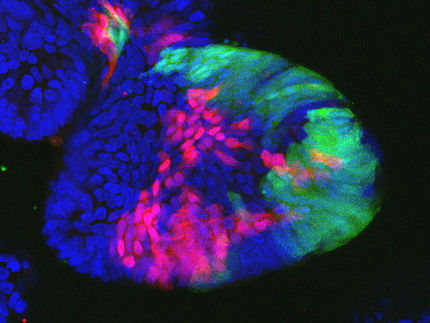Precise Genetics: New CRISPR method enables efficient DNA modification
Two methods combined
The research group led by Prof. Markus Affolter at the Biozentrum, University of Basel, has developed a new method that further improves the existing CRISPR/Cas technologies: it allows a more precise and seamless introduction of tags into proteins at the gene level. This technology could significantly improve research on proteins in living organisms and opens up new possibilities for medical research.
With the revolutionary CRISPR/Cas technology, the DNA of living organisms can be precisely altered. Using a guide RNA that recognizes a specific DNA sequence, Cas9 protein is recruited to that sequence and cuts the DNA. This targeted cut allows the DNA to be repaired or altered at this specific location.
Prof. Markus Affolter's team at the Biozentrum, University of Basel, has now developed a new method called SEED/Harvest in the fruit fly (Drosophila melanogaster). This method combines the CRISPR-Cas9 technique with the Single-Strand Annealing (SSA) repair pathway, enabling genome-wide changes to be carried out more efficiently and without leaving unwanted scars. The study has been published in Developmental Cell.
Two methods combined
The SEED/Harvest method proceeds in two steps. In a first step, the researchers introduced a marker gene into the desired DNA site within a protein-coding region. This marker is placed at the targeted location and is used to isolate successful modifications.
In a second step, the marker is excised and the DNA breakpoints are repaired by the Single-Strand Annealing (SSA) repair pathway. «This enables us to cut the DNA seamless while maintaining its full function», explains first author Gustavo Aguilar. «The combination of both methods makes it possible to mark any desired protein in the genome without collateral damage, allowing us to study the functions of proteins in living organisms.»
More precise and efficient
«Since we would like to introduce and analyze changes in the DNA throughout the genome for our research, the method must be both precise and efficient,» explains Affolter. «And the SEED/Harvest method is both. It combines the most robust screening of successful insertions and all the advantages of seamless tagging.»
New research opportunities
One of the advantages of the SEED/Harvest method is that proteins can be labeled in specific tissues and cell types. «We can now control and determine in various tissues and developmental stages when and where genes are activated or inactivated» adds Gustavo Aguilar. This opens up new possibilities for research to investigate the dynamics of proteins systematically in living cells in real-time.
This method is not only significant for genetics and biotechnology. «The SEED/Harvest method could also be of interest for medical research, for example, to identify defects caused by disease genes,» says Affolter.
Original publication
Most read news
Other news from the department science

Get the life science industry in your inbox
By submitting this form you agree that LUMITOS AG will send you the newsletter(s) selected above by email. Your data will not be passed on to third parties. Your data will be stored and processed in accordance with our data protection regulations. LUMITOS may contact you by email for the purpose of advertising or market and opinion surveys. You can revoke your consent at any time without giving reasons to LUMITOS AG, Ernst-Augustin-Str. 2, 12489 Berlin, Germany or by e-mail at revoke@lumitos.com with effect for the future. In addition, each email contains a link to unsubscribe from the corresponding newsletter.






















































